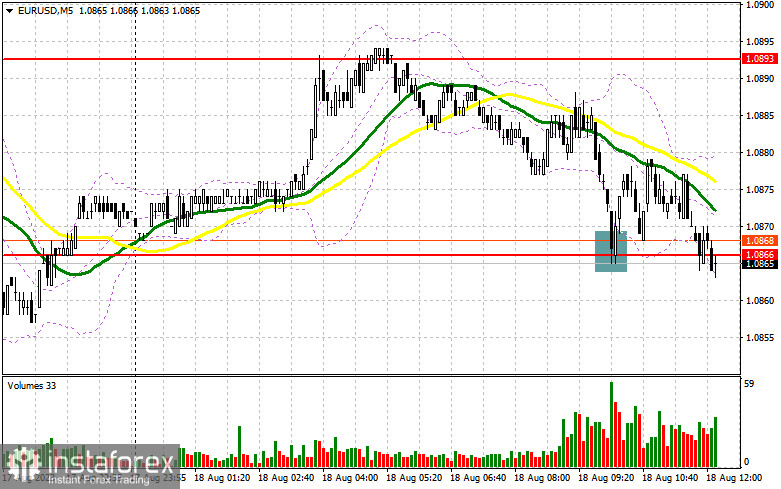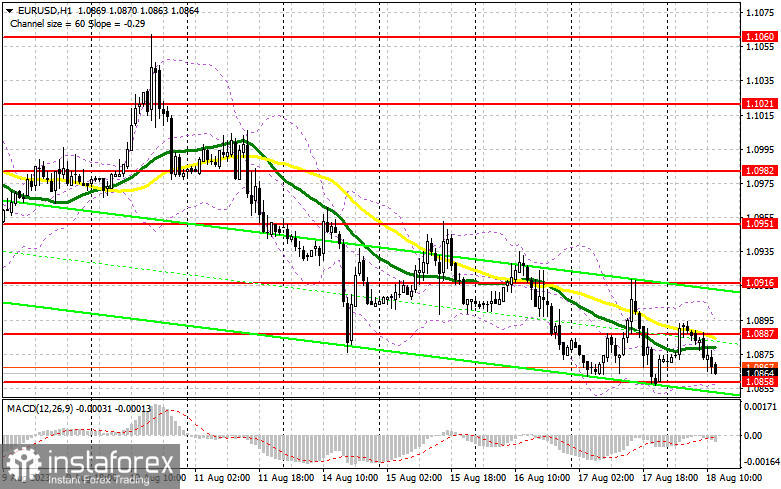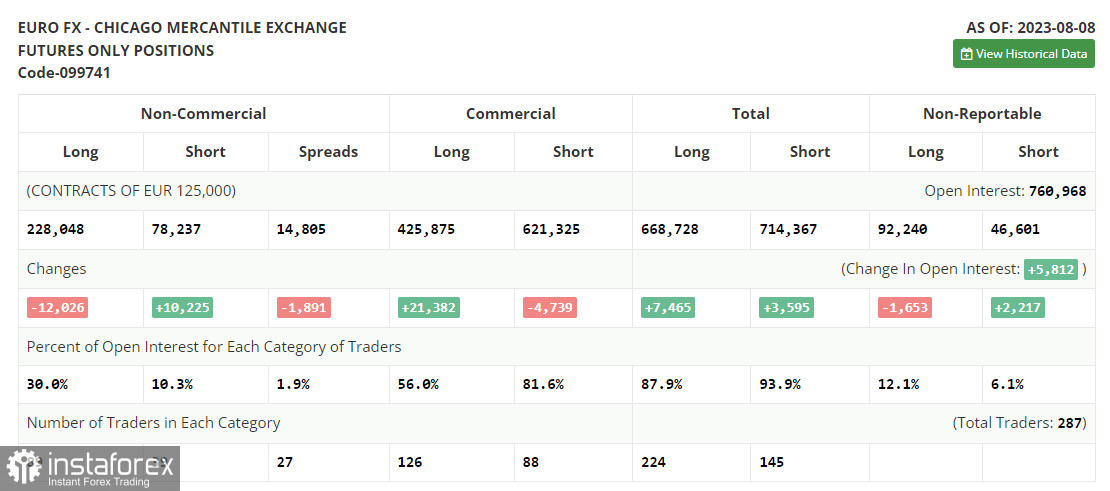In my morning forecast, I drew attention to the 1.0866 level and recommended making market entry decisions based on it. Let's look at the 5-minute chart and figure out what happened there. The decline and formation of a false breakout at this level led to a buy signal, but the upward movement was only about 15 points, after which pressure on the pair returned. For this reason, the technical picture was revised for the second half of the day.

For opening long positions in EURUSD, it is necessary to consider:
The overall consumer price index in the eurozone is slowing down, and the continued high core price pressure did not help euro buyers continue the Asian correction, which brought back pressure on the pair. Given the complete absence of statistics on the US economy in the second half of the day, I expect another drop in the EUR/USD to the area of monthly lows. For this reason, I will now only rely on the protection of the new support level of 1.0858, formed as a result of yesterday. The formation of a false breakout at this level, similar to what I discussed above, will provide a suitable entry point for buying in the development of an upward correction at the end of the week to update the resistance of 1.0887, where the moving averages are located, playing on the side of the bears. A breakout and top-down test of this range will strengthen demand for the euro, giving a chance for a surge upward and a renewal of 1.0916. The furthest target remains the area of 1.0951, where I will be fixing profits. In the case of a decline in EUR/USD and the absence of activity at 1.0858 in the second half of the day, and most likely this is how it will be due to the development of a downward trend, the pressure on the pair will only increase. In this case, only the formation of a false breakout in the area of the next support of 1.0836 – the new monthly minimum, will give a signal to buy the euro. I will open long positions immediately on a rebound from 1.0808 with the aim of an upward correction of 30-35 points within the day.
For opening short positions in EURUSD, it is necessary:
Sellers continue to exert pressure on the pair and are counting on another renewal of monthly lows. However, it is best to act at the end of the week after an increase and the formation of a false breakout in the area of the nearest resistance at 1.0887, which will lead to an excellent sell signal as the bear market continues and the pair falls towards the new support level at 1.0858. Only after breaking through and consolidating below this range and a reverse test from bottom to top can a sell signal be received, opening a direct path to a new low at 1.0836. The furthest target will be the 1.0808 area, indicating the continuation of the bearish trend. I will fix the profit there. In the event of an upward movement of EUR/USD during the American session and the absence of bears at 1.0887, which cannot be ruled out, the bulls will try to re-enter the market. In such a development of events, I will postpone short positions until the next resistance at 1.0916. It is also possible to sell there, but only after unsuccessful consolidation. I will open short positions immediately on a rebound from the maximum of 1.0951 with the aim of a downward correction of 30-35 points.

In the COT report (Commitment of Traders) for August 8th, there was a reduction in long positions and an increase in short positions. All of this occurred before the release of significant inflation data in the US, which, in theory, should have helped determine the Federal Reserve's future policy. However, this did not happen, as prices in the US rose again in July of this year, maintaining the preconditions for further rate hikes by the regulator. However, the euro's fall is quite attractive; despite this, the optimal medium-term strategy remains to buy risky assets on the decline. The COT report indicates that long non-commercial positions decreased by 12,026 to 228,048, while short non-commercial positions increased by 10,225 to 78,237. As a result, the spread between long and short positions decreased by 1,891. The closing price decreased to 1.0981 from 1.0999 a week earlier.

Indicator signals:
Moving Averages
Trading is conducted below the 30 and 50-day moving averages, indicating a further decline in the pair.
Note: The author considers the period and prices of moving averages on the hourly chart H1 and differ from the general definition of classic daily moving averages on the daily chart D1.
Bollinger Bands
In the event of an increase, the upper boundary of the indicator will act as resistance in the area of 1.0858.
Description of indicators
• Moving Average (determines the current trend by smoothing volatility and noise). Period 50. It is marked in yellow on the chart.
• Moving Average (determines the current trend by smoothing volatility and noise). Period 30. It is marked in green on the chart.
• MACD Indicator (Moving Average Convergence/Divergence – measures the convergence/divergence of moving averages). Fast EMA period 12. Slow EMA period 26. SMA period 9.
• Bollinger Bands. Period 20.
• Non-commercial traders – speculators such as individual traders, hedge funds, and large institutions that use the futures market for speculative purposes and meet certain requirements.
• Long non-commercial positions represent the total long open position of non-commercial traders.
• Short non-commercial positions represent the total short open position of non-commercial traders.
• The total non-commercial net position is the difference between non-commercial traders' short and long positions.
 English
English 
 Русский
Русский Bahasa Indonesia
Bahasa Indonesia Bahasa Malay
Bahasa Malay ไทย
ไทย Español
Español Deutsch
Deutsch Български
Български Français
Français Tiếng Việt
Tiếng Việt 中文
中文 বাংলা
বাংলা हिन्दी
हिन्दी Čeština
Čeština Українська
Українська Română
Română

